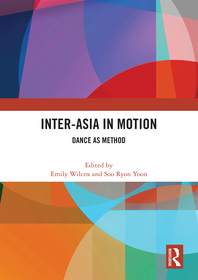
Inter-Asia in Motion
Dance as Method
-
10% KEDVEZMÉNY?
- A kedvezmény csak az 'Értesítés a kedvenc témákról' hírlevelünk címzettjeinek rendeléseire érvényes.
- Kiadói listaár GBP 42.99
-
20 538 Ft (19 560 Ft + 5% áfa)
Az ár azért becsült, mert a rendelés pillanatában nem lehet pontosan tudni, hogy a beérkezéskor milyen lesz a forint árfolyama az adott termék eredeti devizájához képest. Ha a forint romlana, kissé többet, ha javulna, kissé kevesebbet kell majd fizetnie.
- Kedvezmény(ek) 10% (cc. 2 054 Ft off)
- Kedvezményes ár 18 484 Ft (17 604 Ft + 5% áfa)
Iratkozzon fel most és részesüljön kedvezőbb árainkból!
Feliratkozom
20 538 Ft

Beszerezhetőség
Becsült beszerzési idő: A Prosperónál jelenleg nincsen raktáron, de a kiadónál igen. Beszerzés kb. 3-5 hét..
A Prosperónál jelenleg nincsen raktáron.
Why don't you give exact delivery time?
A beszerzés időigényét az eddigi tapasztalatokra alapozva adjuk meg. Azért becsült, mert a terméket külföldről hozzuk be, így a kiadó kiszolgálásának pillanatnyi gyorsaságától is függ. A megadottnál gyorsabb és lassabb szállítás is elképzelhető, de mindent megteszünk, hogy Ön a lehető leghamarabb jusson hozzá a termékhez.
A termék adatai:
- Kiadás sorszáma 1
- Kiadó Routledge
- Megjelenés dátuma 2025. augusztus 29.
- ISBN 9781032561608
- Kötéstípus Puhakötés
- Terjedelem232 oldal
- Méret 246x174 mm
- Súly 430 g
- Nyelv angol 691
Kategóriák
Rövid leírás:
This book explores dance and choreography as sites for the articulation of new theoretical and historical paradigms in inter-Asia cultural studies. It covers a range of dance works, artists, genres, and media, from Kathak to K-pop flash mob dance, Cold War diplomacy to avant-garde dance collaborations, and festival dance to dance on screen.
TöbbHosszú leírás:
This book explores dance and choreography as sites for the articulation of new theoretical and historical paradigms in inter-Asia cultural studies.
The chapters in this volume cover a wide range of dance works, artists, genres, and media, from Kathak to K-pop flash mob dance, from Cold War diplomacy to avant-garde dance collaborations, and from festival dance to dance on screen. Working against the Western-centric category of “Asian dance” and Western-centric theorizations of intercultural performance that foreground “East-West” relationships, each contribution shows how dances in Asia make one another as their key aesthetic references beyond Eurocentric influences, as well as how inter-Asia relations emerge from cultural, geographical, and aesthetic diversity within the region. This book is the first of its kind in both cultural studies and dance studies. It will contribute greatly to readers’ understanding of how performance shapes and transforms the cultural and political dynamics of inter-Asia, with a focus on dance circulations in and across East, South, and Southeast Asia.
Inter-Asia in Motion: Dance as Method will be a key resource for academics, researchers, and advanced students of Dance Studies, Performance Studies, Cultural Studies, Asian Studies, International Relations and Politics, History, and Sociology. The chapters included in this book were originally published in Inter-Asia Cultural Studies.
TöbbTartalomjegyzék:
Introduction 1. “Gangnam Style” in Dhaka and inter-Asian refraction 2. Performing Bandung: China’s dance diplomacy with India, Indonesia, and Burma, 1953–1962 3. Choreographing neutrality: dance in Cambodia’s Cold War diplomacy in Asia, 1953–1970 4. Geographies of the classical: Kathak across India and Hong Kong 5. Inter-Asian dance as method, artistic research as method: Nam Hwayeon’s work on Choi Seung-hee 6. The aesthetics of intercultural method: from process to procession in new Indonesian and Indo-Australian dance 7. Bharatanatyam and Buddhist diplomacy: inter-Asia significations in Santha Bhaskar’s Anweshana: The Search for Nalanda 8. “The nightingale is a graceful dancer”: Bulbul Chowdhury, dance heritage, and the new nation-state of Pakistan 9. Dancers in the Japanese entertainment troupe of comfort in the 1940s: traveling along the Burma–China frontline 10. Dancing me from South to South: on Wu-Kang Chen and Pichet Klunchun’s intercultural performance 11. Japanese dancers, Bollywood dance: finding authenticity at Tokyo’s Namaste India Festival 12. Multicultural dance-making in Singapore: Merdeka, youth solidarity and cross-ethnicity, 1955–1980s
Több








